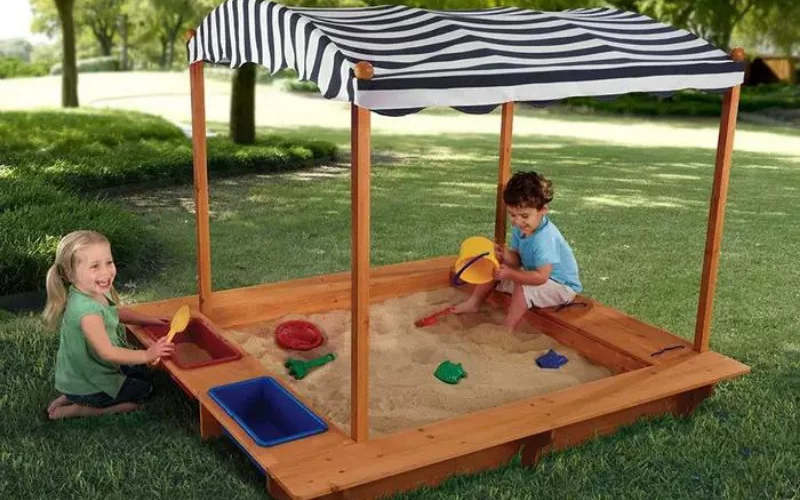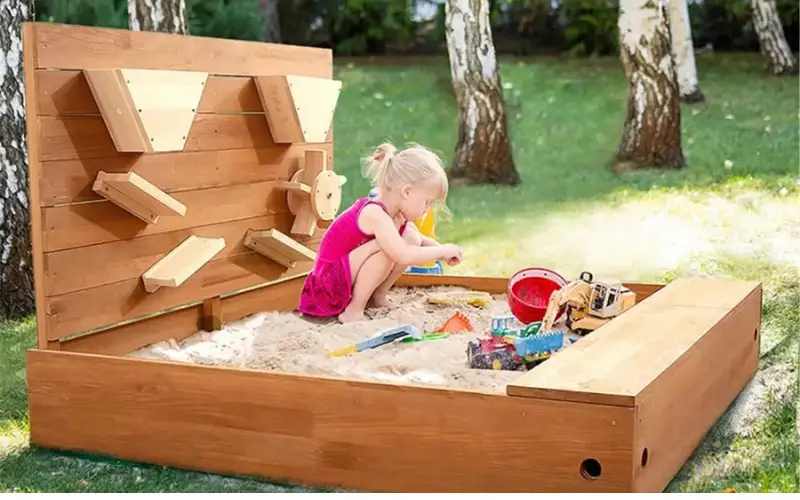Kids love to play in the sand, and wherever they find sand, they find fun and excitement; this is why they love going to the beach. However, the sandbox has been able to bring the beach to the kids, which is why it is a rave for them, especially toddlers.
It is important to know how much sand it will take to fill your kids’ sandbox as a parent. This is an easy catch once you know the sandbox dimension, and with a little calculation, you can be sure of how much sand will fit into the sandbox.
In this article, we also discussed how to care for your sandbox so that they remain safe for your kids to play in. We also mentioned playing materials you can get for your kids as they play away in their sandbox.
Is Playing In Sandboxes Good For Kids
Sandboxes are not just places where young kids play, build sand and generally have fun. Yes, kids have a good time as they play in the sandbox. However, there are lots of ways that this play benefits the kids, including:
Kids learn practical skills, social skills, and more.
1. It teaches them how to explore as they sift, dump, and mold sand with their hands. As they work with their hands, experts say it is the perfect way they learn about their environment.
2. It helps kids’ imaginative ability because as they play and mold things in the sand, it helps them imagine different things and even construct them using the sand in the sandbox. This is a good way for kids to develop their creative potential and use their imaginations constructively.
Strengthen finger and hand muscles and improve coordination, which are precursors for handwriting, sports, and self-sufficiency tasks like buttoning clothes and tying shoes.
3. Playing with sand on Sandboxes strengthens toddlers’ hand muscles and improves their coordination; these will help them later in writing, buttoning their shirts, tying their shoelaces, and generally improve their coordination.
4. As they play in the sand with their friends, they practice and develop social skills like interacting and communicating with other kids.
5. Kids learn how to work together with others as they work together in building different things with sand from the sandbox. Kids in the process learn the act of brainstorming and negotiation.
Sand Calculator: How Much Sand Do I Need

Let’s get straight to business. To calculate the amount of sand and sandbag you will need for your sandbox, you follow the steps below:
Step 1: Determine The Area Of The Sandbox
Before you can determine the quantity of sand your sandbox will need, you will have to determine the sandbox area you have. For a new sandbox, you will find this information in the package, but if not, use a measuring tape to measure the dimension of the sandbox.
If you have a rectangular Sandbox, the area will be length × breadth. So if your sandbox is 7′ x 5′, you’ll have 35 square feet. For a square-shaped sandbox, the area will be: length raised to the power of two( length × length)
Step 2: Determine How Deep You Want The Sand
It is always good not to fill the sandbox so that the kids can play without messing up the whole place, not to mention that you cannot put the protective covers over the sandbox if it is too full; hence you have to decide how deep you want the sand in the sandbox.
So if the area of your rectangular sandbox is 7′ x 5′, and you want it to be 6″ deep ( a depth of 6″ is ideal)
Step 3: Now Calculate The Volume Of Sand You Need
Once you know the dimension of your sandbox and the depth of sand you want, it is easy to calculate the quantity of sand you will need. So, all you need to do is multiply the sandbox’s area by the depth you want the sand to reach in the sandbox.
So for the rectangular sandbox in step 2 above, the volume is 7′ × 5′ × 6.”
Since all our dimensions must be in the same unit, hence we convert inches to feet by dividing the value in inches by 12 ( 12 inches makes 1 foot)
6 inches into feet by dividing it by 12
Hence 6/12 = 0.5′
Therefore volume is 7′ × 5′ × 0.5 = 17. 5. Cubic feet.
Step 4: Calculate The Number Of Sandbags You Will Need
Most play sands are sold in a 50 lb bag, and each bag contains about ½ cubic feet of sand. To determine how many bags of sand you will need, divide the volume of the sandbox by ½.
So using the example in step 3,
The number of bags of sand you need will be:
17.5 × ½ = 30 bags
You can do this calculation for any shape of a sandbox once you can calculate its area.
How To Calculate The Number Of Sand For Circular Sandbox
The same steps you followed in calculating the quantity of sand and the number of Sandbags you will need for your rectangular or square sandbox are the same steps you adhere to in working with a circular sandbox. The steps include:
Step 1: Calculate the area of the circular sandbox; to do that, you have to measure the radius or diameter of the circular base.
The formula for the area of a circle = πr2
Where:
π, which is pi, has the value of 3.14
r stands for the radius of the circle. The value of the radius is raised to the power of 2.
Step 2: Calculate the area now.
So assuming you measured the radios of the circular sandbox and you got the value of 3.5.’
Therefore the area will be 3.14 × 3.5 × 3.5.
Step 3: You now decide the depth you want the sand to reach in the sandbox, then multiply the answer by the area you calculated in step 2 above.
Assuming you want the depth of the sandbox to be 4.”
You then have to convert the 4 inches to feet by dividing it by 12. Hence 4″ converted to feet is:
4/12= 0.33
This means the volume will be:
3.14 × 3.5 × 3.5 × 0.33 = 12.7 cubic feet
Step 4: Then divide your answer by ½ to calculate the number of bags you need.
Hence, 12.7 × ½ = 25. 4 bags of sand.
Creating A Clean Sandbox For Kids
Sandbox is meant mostly for toddlers who need to play in a clean and sanitary environment, so they don’t contract an infection as they play on the sand. Here are step-by-step procedures for cleaning a sandbox:
1. First and foremost, ensure that the sandbox and the sand inside are free of any dirt, insects, slugs, leaves, debris, or any germ or bacteria.
2. If the kids pee in the sand, or you notice that there is animal pee or poop on the sand, dispose of the sand immediately and dispose of them properly, either into a landfill or check k if your waste company will dispose of them for you.
3. Every so often, remove the sand in the sandbox and then clean and disinfect the sandbox using a hose to get rid of all dirt and debris. Wear a glove while you are cleaning the sandbox and ensure that you clean the inside with both soap and disinfectant
4. Kill all bugs and larvae that you find in the sandbox with a regular insecticide. Afterward, allow the sandbox for 3 or 4 days before cleaning it out with warm soapy water.
5. If your Sandbox is homemade and wooden, then add a new bottom liner of landscape fabric or heavy plastic so that bugs, spiders, slugs, or any dirt do not get in from the bottom.
6. You can now replace the old sand with the right amount of play Sand which is usually labeled as “Sand for Sandbox.” Ensure that the sand you are using is clean, disinfected, and ready-to-go sand. You can ward off crawling and creeping insects from the sandbox by mixing a jar of cinnamon with the sand, which will repel insects.
How to Stock Your Sandbox
If you want your kids to thoroughly enjoy themselves as they play in the sandbox, there are a few toys and tools you should provide along with the sandbox. They include
- Kitchen tools
- Small wood boards or cardboard work
- Transportation-related items
- Molds of shapes
- Natural items like stones, twigs, fossils, and shells.
- Funnels
- Small buckets
- Jars and cups
- PVC pipes (for building tunnels)
- Sifters
- Small garden tools
- Paintbrushes
- Spray bottles with colored water
Conclusion
Sandboxes are a great addition to the fun things your kids have for having a good time. They are beneficial in helping the kids physically and also mentally.
You can determine how much sand will fit into your kid’s sandbox once you calculate the area. You should also ensure that the sandbox is always clean so that your kids don’t contract infections while trying to have fun.
Helpful Links:
We trust this article helped you know how much sand you need for a sandbox. You may also want to check out How to Dry Sand in a Sandbox.
Thanks for taking the time to read our article, and we hope you find it helpful. Would you mind leaving a comment below if you have any suggestions?
Kindly reach out to people by sharing this post on social media.
If you liked this article, then please follow us on Facebook, Instagram, and Pinterest.

